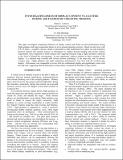| dc.description.abstract | This paper investigates competing influences of display content and clutter on pilot performance during
flight guidance and target acquisition phases of air-to-ground targeting missions. Based on interviews with
F/A-18 pilots, a cognitive process model is presented to help understand how pilots use and transition
between internal and external sources of information to support decision-making and aircraft control.
Experiments were conducted in which subjects flew targeting missions using a flight simulator connected
to the Navy’s FalconView moving-map. In one experiment, subjects referred to three versions of the
display: 1) a detailed map overlaid with critical mission symbology, 2) the map only, and 3) mission
overlays only. Flight guidance and target acquisition performances were best with the overlays-only
display. Performance was comparable or worse with the combination display and significantly worse with
the map only, suggesting that the distraction of map clutter countered the benefits of map content. | en |
